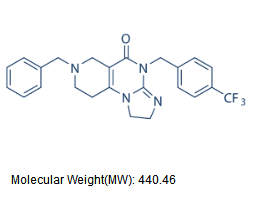All AbMole products are for research use only, cannot be used for human consumption.

The ClpP activator ONC‐212 (TR‐31), a fluorinated-ONC201 analogue, is broadly efficacious across most solid tumors and hematological malignancies in the low nanomolar range and has robust anti-leukemic activity.
In vitro: ONC212 shows an anti-proliferative effect in a large panel of pancreatic cancer cell lines with ONC212 having at least a ten-fold increased potency than ONC201. ONC212 induces apoptosis earlier and at lower concentrations than ONC201 in sensitive pancreatic cancer cell lines. ONC212 exerts potent and prominent apoptogenic effects on acute myeloid leukemia (AML) and mantle cell lymphoma (MCL) cell lines (e.g., ED50s of 141.0 nM in p53 wild-type OCI-AML3 cells, 105.7 nM in MOLM13 cells, and 265.2 nM in p53-null JeKo-1 cell lines). Time course analysis of apoptosis in OCI-AML3 cells shows that ONC212 takes more than 36 hours to start to induce apoptosis. ONC212 significantly induces Sub-G1 apoptotic cells and/or cell cycle arrest.
In vivo: ONC212 shows improved efficacy in melanoma and hepatocellular carcinoma xenograft models. ONC212 has a broad therapeutic window, an acceptable PK profile, and is orally well-tolerated in mice with no evidence of toxicity at efficacious doses in both colon and triple negative breast cancer. ONC212 exhibits rapid kinetics of activity. ONC212 has a slightly shorter half-life than ONC201, with a clearance from the blood at 12 hours, T1/2 of 4.3 hours, and Cmax of 1.4 mg/mL. It has a prolonged pharmacodynamic effect despite systemic clearance. Oral ONC212 shows potent anti-tumor efficacy in a human melanoma xenograft and hepatocellular model. ONC206 and ONC201 both inhibit invasion and migration of tumor cells while ONC212 inhibits only invasion.
| Cell Experiment | |
|---|---|
| Cell lines | PANC-1 and HPAF-Ⅱ cells |
| Preparation method | Colony formation assays are performed by seeding 0.2 × 10^6 cells/well in a 6-well plate and treatment with indicated doses of ONC201 or ONC212. At 72 hours post-treatment, cells are harvested and 500 cells per treatment group are plated in drug-free media in triplicate for colony formation. Colonies are stained with 0.25% crystal violet on Day 10, imaged, counted and reported as number of colonies ± SEM. |
| Concentrations | 5 µM or 20 µM |
| Incubation time | 72 h |
| Animal Experiment | |
|---|---|
| Animal models | PANC-1, Capan-2, HPAF-II and BxPC3 xenograft models (athymic nu/nu mice) |
| Formulation | 10% DMSO, 20% Kolliphor EL (Sigma), 70% PBS |
| Dosages | 50 mg/kg |
| Administration | oral gavage |
| Molecular Weight | 440.46 |
| Formula | C24H23F3N4O |
| CAS Number | 1807861-48-8 |
| Solubility (25°C) | DMSO 45 mg/mL (ultrasonic) |
| Storage |
Powder -20°C 3 years ; 4°C 2 years In solvent -80°C 6 months ; -20°C 1 month |
| Related Apoptosis Products |
|---|
| Coenzyme Q0
Coenzyme Q0 (CoQ0) is a potent, oral active ubiquinone compound. Coenzyme Q0 induces apoptosis and autophagy, suppresses of HER-2/AKT/mTOR signaling to potentiate the apoptosis and autophagy mechanisms. Coenzyme Q0 regulates NFκB/AP-1 activation and enhances Nrf2 stabilization in attenuation of inflammation and redox imbalance. |
| C6 Ceramide
C6 Ceramide (C6-Cer) is a short-chain, cell-permeable ceramide pathway activator with anticancer activity. C6 Ceramide-mediated miR-29b expression participates in the progression of multiple myeloma through suppressing the proliferation, migration and angiogenesis of endothelial cells by targeting Akt signal pathway. |
| DB2115 tertahydrochloride
DB2115 tertahydrochloride is a potent inhibitor of myeloid master regulator PU.1. DB2115 tertahydrochloride has the potential for researching cancers, including hematologic cancers. |
| 14-3-3η Protein inhibitor 1
14-3-3η Protein inhibitor 1 is a 14-3-3η protein inhibitor with a KD of 35 µM. |
| Deferoxamine
Deferoxamine (Deferoxamine B) is an iron chelator (binds to Fe(III) and many other metal cations), is widely used to reduce iron accumulation and deposition in tissues. Deferoxamine upregulates HIF-1α levels with good antioxidant activity. Deferoxamine also shows anti-proliferative activity, can induce apoptosis and autophagy in cancer cells. |
All AbMole products are for research use only, cannot be used for human consumption or veterinary use. We do not provide products or services to individuals. Please comply with the intended use and do not use AbMole products for any other purpose.


Products are for research use only. Not for human use. We do not sell to patients.
© Copyright 2010-2024 AbMole BioScience. All Rights Reserved.
